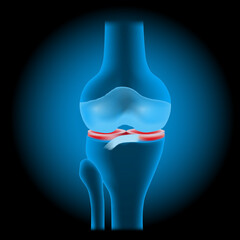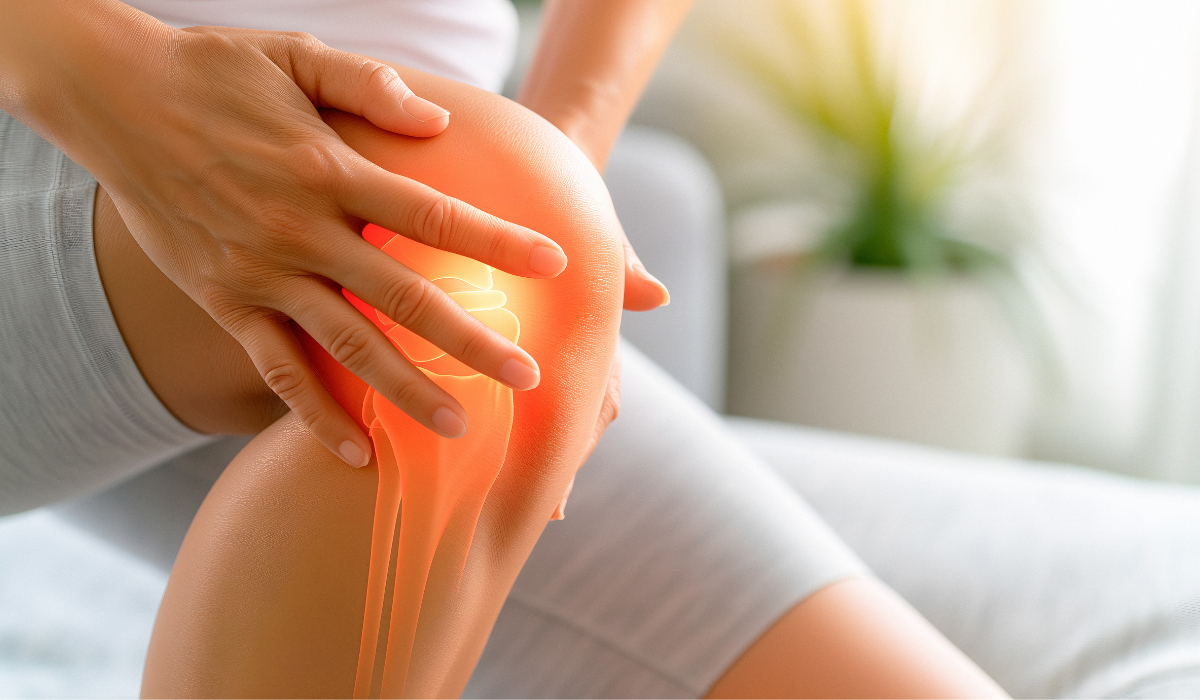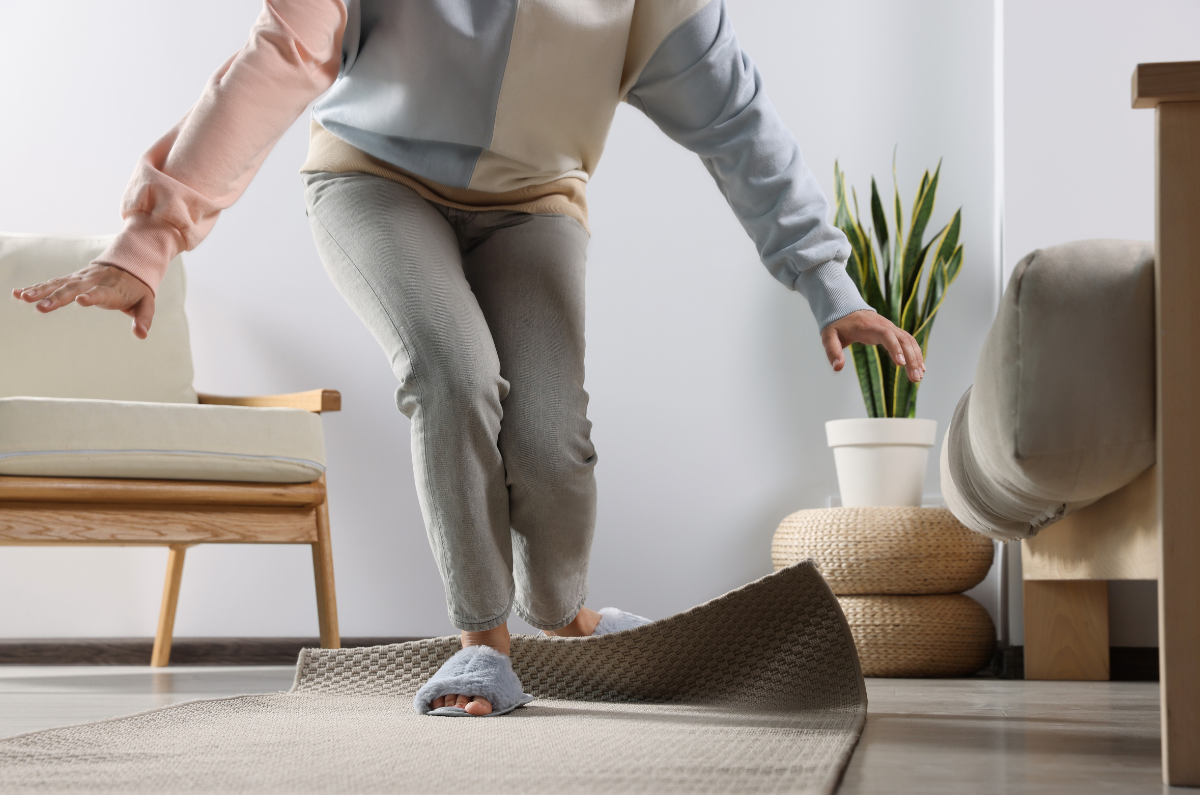Tips for preventing falls
The 80’s song ‘catch me I’m falling’ could have been my family anthem. We’re clumsy, uncoordinated, and with two left feet, always slipping, tripping, and falling. 😁
It‘s just the way we are. I’ve even gotten to the point of doing a ‘ta-da’ after a trip, extending my arms over my head like a gymnast at the end of a routine.😀
But now, as I’m getting older, it’s not so amusing. I’m conscious of the more serious repercussions of falling. In fact, just last week, I tripped over my cat, whacked the side of my head on the kitchen counter and broke my glasses. Fortunately, I wasn’t seriously injured. But it made me take stock, stop thinking about falls as something I have to put up with and start being more proactive in preventing them.
Because the good news is that falls aren’t inevitable. They can often be prevented, or at the least, any injuries that occur can be minimised.
Let’s start with some facts
Data from the Australian Institute of Health and Welfare shows that falls are Australia’s largest contributor to injuries that require a stay in hospital and are a leading cause of injury deaths.(1) More than half of the hospitalisations were due to broken bones – often hips, vertebrae and wrists.
Falls can happen anywhere and to anyone, but a fall that lands you in hospital is more common in older people and most likely to occur in the home.
The stats are alarming, and like me, you may think these were falls from a height or down stairs. But the truth is, ‘over half of all falls leading to hospitalisation occurred on a single-level surface (for example, by slipping), and only 7% of falls leading to hospitalisation involved stairs or steps.’(1) 😱
And if you have osteoporosis and your bones are already fragile, the risk of breaking a bone due to a fall is much greater.
So to avoid becoming one of these stats, we can’t see falls as an inevitable part of life and getting older. They’re a serious problem, and we all need to take steps to prevent them.
We know that falls can result in broken bones, but they can also cause:
- Dislocated joints (e.g. shoulder)
- Head injuries
- Bruises, scrapes and sprains
- A loss of confidence which can lead to restricting activities due to the fear of falling. For example, avoiding walks in the park or going into places that are unfamiliar, crowded or have stairs/steps due to fear of falls,
What causes people to fall?
Health issues
- If you’ve fallen more than once in the past 6 months, you’re more likely to fall again.(2)
- Medical conditions that lead to reduced strength and endurance (e.g. arthritis), loss of sensation (e.g. diabetic neuropathy), impaired balance (e.g. Parkinson’s disease) and cognitive impairment (e.g. dementia).
- Medicine side effects, especially if you’re taking several medicines.
- Poor eyesight and vision problems.
- Incontinence. Rushing to the toilet can increase your risk of falling, especially at night.
The environment
- Trip hazards in your home and the community, e.g. clutter, cords and cables, wet and/or slippery floors, uneven footpaths, and pets.
- Poor lighting.
- Inappropriate or ill-fitting footwear and clothing.
Reducing your risk
Falls are usually caused by a combination of factors. Changing some of these factors can lower your chances of falling. Or, if you do fall, reduce your risk of serious injury.
Exercise regularly
Australian physical activity and exercise guidelines recommend that all adults be active most days, preferably every day, for 30 minutes or more. Exercise is vital for good health, maintaining independence, and lowering your risk of falls and fall-related injuries. Physical activity helps to maintain and improve your mobility, strength, posture, coordination, balance and flexibility.
People with better posture, better balance and stronger muscles are less likely to fall or be injured. On the other hand, people who aren’t very active are more likely to fall and be injured than those who are more active.
Talk with your doctor, physiotherapist or exercise physiologist for information and advice about how you can safely become more active.
And read Exercise for preventing falls by The Royal Australian College of General Practitioners for more info.
Look after your health
- Talk with your doctor about your medicines. Some medicines can help reduce falls, such as pain-relievers that decrease your pain and allow you to move more comfortably and be more active. However, some medicines or combinations of medicines can cause dizziness, drowsiness or confusion, which increases your risk of falling. Understanding your medicines and how they affect you is an important strategy for reducing this risk.
- Eat a healthy, balanced diet with regular meals throughout the day to avoid feeling lightheaded, weak or dizzy. Stay hydrated and drink plenty of water each day.
- Limit alcohol intake as it can affect your balance and coordination and increase your risk of falling.
- Have your eyes tested regularly by an optometrist. If you wear glasses, keep them clean. If you have different glasses for different situations, e.g. reading or distance glasses, make sure you use the appropriate ones for the task. Be careful when going up and down stairs if you wear multifocals.
- Wear sunglasses outside to minimise glare and squinting and to protect your eyes from UV damage.
- When moving from a light to a dark space, or vice versa, allow time for your eyes to adjust.
- See a podiatrist if you have problems with your feet that affect your balance or how you walk; for example, pins and needles, pain, swelling, or poor circulation. They can help you address these issues. They can also give you advice about appropriate footwear.
- Take time to regain your balance after lying down or standing up after sitting.
Move around safely
- If you’re unsteady on your feet or have painful feet, hips or knees, you may need some support to get around. A physiotherapist or occupational therapist can help you decide if a mobility aid (e.g. a walking stick or walker) is appropriate for you. They’ll also help you learn how to use it correctly and adjust it to your requirements.
- Plan your outings to fit how you’re feeling. For example, if you’re at the shopping centre and feel tired or your feet begin to hurt, you might need to sit and rest for a while. Or, avoid going for a long walk if you’re having a day when your pain and fatigue levels are high. Take a shorter walk instead.
- Be aware of the weather and how it can affect your environment. For example, footpaths are often slippery when wet, especially if there are wet leaves on them. Or, on sunny days, sun glare can make visibility more difficult, and you may not be able to see as clearly as usual.
Choose your clothing and footwear carefully
- Avoid long trousers or skirts that may get caught underfoot or on furniture.
- Wear well-fitting, supportive shoes with non-slip soles. Avoid high heels, floppy slippers, shoes with slick soles, and walking around in your socks.
- Hip protectors may be an option for people with osteoporosis or those who fall often. They’re plastic shields or foam pads that fit into the pockets of specially designed underwear and reduce hip fractures from a fall. Your doctor can give you more information about hip protectors.
Reduce the hazards in your home
- Make sure mats, rugs and carpet edges are lying flat on the ground and well secured. If they’re loose or curled up, they can cause you to trip.
- Clean up spills from the floor immediately. If you have balance issues and bending over is a problem, ask someone else to clean the floor or use a light mop.
- Ensure your walkways are clear of clutter, and you have plenty of space to walk between furniture without anything getting in your way.
- Remove cords and cables from walkways. Secure them to skirting boards or close to the wall.
- Install non-slip mats in the bathroom.
- Pets can be a trip hazard (as I learned the hard way), especially if they like to be close to you or it’s meal time. 😼 So be aware of where they are when you’re up and about. 🐶
- Make sure your home is well-lit so you can always see where you’re going. If you get up in the night frequently to go to the toilet, make sure you have a bright bedside light or use a torch so you can see clearly. Motion sensor lights are also handy and can be plugged into power points on the way to the toilet.
- Consider installing a handrail on at least one side of any stairs and next to baths, showers and toilets.
- Safety strips on the edges of outdoor stairs are also a good idea. They provide additional grip and help you see exactly where the edge of the step is.
What to do if you fall
Sometimes, no matter how careful you are, you can still have a fall.
So if you have a fall, it’s important that you try not to panic (easier said than done 😑). And although your first reaction may be to get up quickly, especially if you’re in public, because you’re embarrassed (been there, done that), take a moment.
- Assess the situation. Are you hurt? Is it safe to get up? Have you damaged your glasses? Or lost your walking stick?
- Make a decision whether or not to try to get up. Factoring into your decision will be whether you’re safe where you are, e.g. have you fallen onto a footpath or the road?
If you can get up:
- Take time to recover. Sit and let yourself get over the shock. Drink some water. Take stock of your injuries.
- Tell someone you’ve had a fall and/or seek medical advice. Don’t just brush it off. Falls can signify that something’s wrong – e.g. medicine side effects, balance problems, or a new health issue.
If you can’t get up:
- Try sliding or crawling to seek help.
- Use your phone or personal alarm, call for help or make a loud noise to attract attention.
- Make yourself as comfortable as possible until help arrives
- Seek medical advice/or call an ambulance.
Services to help keep you safe
If you’ve done all you can to prevent falls and are still concerned about your risk, there are services available to help you.
- Falls and balance clinics provide multidisciplinary assessment and management planning for people who’ve had falls and have mobility and balance problems. People receive information on making their homes safer and are referred to physiotherapy, occupational therapy, exercise classes and other allied health professionals. Talk with your doctor about whether this might be an option for you.
- Personal alarms. There are two basic personal alarm options; a pendant you wear around your neck and a smartwatch worn on your wrist. Pressing the button on the alarm will trigger contact with the service company, who’ll then contact your nominated relative, friend, neighbour or a response service. Some people can access free or reduced-cost personal alarms through government schemes such as the Commonwealth Home Support Program, National Disability Insurance Scheme (NDIS) and Department of Veterans’ Affairs. Visit their websites or speak with your doctor to see if you’re eligible. A variety of private companies provide this service for a fee if you don’t qualify for the free service.
- Red Cross Telecross is a free service offered by the Australian Red Cross. It aims to provide people who live alone and are at risk of illness or accident the peace of mind that someone is looking out for them. Each morning, every day of the year, trained volunteers make a short call to people’s homes. If the call goes unanswered, Red Cross will take action to make sure that the person is OK. For information about accessing Telecross, call Red Cross on 1300 885 698.
More to explore
References
(1) Falls, Australian Institute of Health and Welfare, 2022.
(2) Falls and the elderly, healthdirect, 2020.
Originally written and published by Lisa Bywaters 2022.












